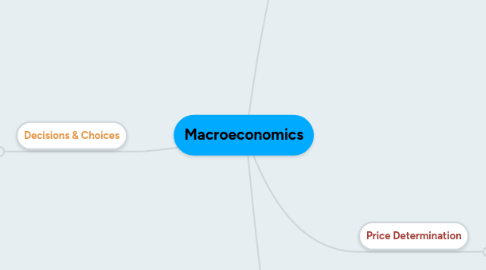
1. Decisions & Choices
1.1. Responding to Incentives, which are things that motivate and encourage us to do something
1.1.1. Capitalism
1.1.1.1. Motivated by self-interest to get what they want. People are free to use their own funds to buy, sell and produce. Owners can adjust productivity to adjust profitability.
1.1.2. Central Planning
1.1.2.1. A planner controls what goods are produced and their prices. This can lead to shortages or surpluses.
1.2. Marginal Cost vs. Marginal Benefit
1.2.1. If marginal benefit (what people are willing to give up in order to obtain one more unit of a good) >>>> marginal cost (value of what is given up), then the decision should be made.
2. Measurements of Economic Performance
2.1. Inflation
2.2. Unemployment
2.3. Gross Domestic Product (GDP)
2.3.1. Components of GDP
2.3.1.1. Personal Consumption
2.3.1.2. Investment
2.3.1.3. Net Exports
2.3.1.4. Government Spending
2.3.2. Real vs. Nominal GDP
2.3.2.1. Real values are adjusted for inflation, therefore it is a better measure for economic performance. However, real GDP PER capita shows how well an average person performs, or their standard of living.
2.3.2.2. Nominal values are not adjusted for inflation, therefore, appear higher than real GDP
2.3.3. National Debt to GDP Ratio
2.3.3.1. Our debt as GDP % continues to rise. Government spending, a component of GDP, is too high, therefore we have less revenue. To fix this, corporate welfare should be eliminated, taxes should be done implemented differently and we must eliminate distortions in policies.
3. Price Determination
3.1. Supply
3.1.1. Factors Affecting Supply
3.1.1.1. The size of the industry, ex. The larger the industry, the more supply
3.1.1.2. Technological progress/innovation
3.1.1.3. Prices of inputs, ex. Increase in "costs" of land, capital, labor (factors of production)
3.1.1.4. Taxes
3.2. Demand
3.2.1. Factors Causing a Shift in Demand
3.2.1.1. Population Size, ex. Increase in population = increase in demand
3.2.1.2. Normal Good vs. Inferior Good, ex. with increase in income, demand increases for normal goods, such as a new car or more expensive dinners
3.2.1.3. Complementary Goods (goods used together) vs. Substitute Goods (goods that replace each other)
3.3. Equilibrium Price
3.3.1. Price that balances out quantity supplied and quantity demanded
4. International Trade
4.1. Comparative Advantage
4.1.1. Opportunity Cost
4.1.1.1. Each good should be produced by the country with the LOWER opportunity cost of producing that good. This means the country producing is 'giving up less to obtain that good/service.'
4.2. Specialization
4.2.1. Countries maximize their utilization of resources by specializing in the production of goods or services where they are most efficient and have a large advantage over their trade partners.
4.3. Exports & Imports
4.3.1. It is better to have a greater value of exports than imports. This causes a positive balance of trade and a surplus, meaning the country is selling more than buying.
